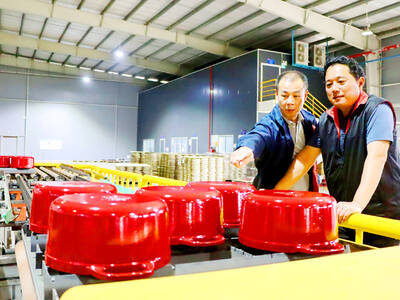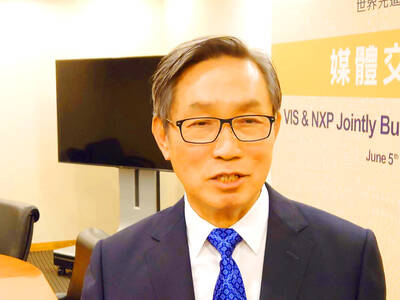Taiwan Semiconductor Manufacturing Co (TSMC, 台積電) yesterday posted its second-highest monthly revenue totaling NT$206.03 billion (US$6.57 billion) for last month on constant robust demand for its 3-nanometer chips used in iPhones, boding well as a sign that the chipmaker would hit its quarterly revenue target.
Revenue last month retreated to an annual contraction of 7.5 percent to NT$206.03 billion, compared with NT$222.71 billion. That represented a monthly decline of 15.3 percent from NT$243.2 billion in October, when its monthly revenue climbed to an all-time high.
In the first two months of this quarter, TSMC accumulated a combined NT$449.23 billion in revenue, achieving about 76 percent of the lower end of the chipmaker’s revenue guidance of US$18.8 billion. TSMC estimated in October that revenue this quarter would expand about 11 percent sequentially.

Photo: Reuters, Ann Wang
The Hsinchu-based company at the time attributed the revenue growth to strong demand for its 3-nanometer and 5-nanometer technology used to make smartphones and artificial intelligence (AI) chips, providing a cushion to weakness in chips used in other applications due to a longer-than-expected inventory correction cycle.
TSMC is keeping a high utilization of about 90 percent for its 3-nanometer technology equipment during the current quarter, and the figure is to be elevated to about 95 percent in the first half of next year and rise even higher in the second half, an International Data Corp’s (IDC) projection on Thursday showed.
TSMC is benefiting from the rollout of new flagship smartphone processors by customers such as MediaTek Inc (聯發科), Qualcomm Inc, Intel Corp and Advanced Micro Devices Inc (AMD), who are to join Apple in adopting TSMC’s 3-nanometer chips during the second half of next year, IDC senior research manager Galen Zeng (曾冠緯) said.
Apple is to go one step further by using TSMC’s enhanced version of 3-nanometer technology for its newest A18 processor next year, Zeng said.
With a broader customer base, TSMC expects 3-nanometer chips to contribute a greater revenue share next year, compared with about 5 percent this year, the first year it ramped up production of the foundry industry’s most advanced process technology.
TSMC also plans to maintain a high equipment utilization rate for its 4-nanometer and 5-nanometer technologies for the entirety of next year at more than 80 percent, given the lofty demand for AI processors and AI accelerators, Zeng said.
To satiate customers’ strong appetite for AI chips, primarily from Nvidia Corp, TSMC is planning to more than double its capacity for advanced packaging technology, or chip-on-wafer-on-substrate (CoWoS) technology to solve its supply deficiency.
TSMC still faces a 20 percent supply gap to fill, Zeng said, adding that the supply constraints are to ease in the second half of next year, when TSMC is to complete its CoWoS capacity expansion.
TSMC’s CoWoS capacity is to surge about 130 percent to 32,000 wafers per month by the end of next year, up from 14,000, Zeng estimated.
That was an upgrade from an earlier estimate three months prior of 28,000 wafers, due to faster equipment acquisitions, he said.
The global semiconductor market is to resume annual growth of 20.2 percent next year to US$633 billion, up from US$527 billion this year, attributable to growing demand for AI-related chips, vehicle chips and a recovery of memory chips, IDC predicted.
This year would be a tough year, with the market size set to shrink 12 percent annually, the researcher forecast.

STEEP DECLINE: Yesterday’s drop was the third-steepest in its history, the steepest being Monday’s drop in the wake of the tariff announcement on Wednesday last week Taiwanese stocks continued their heavy sell-off yesterday, as concerns over US tariffs and unwinding of leveraged bets weighed on the market. The benchmark TAIEX plunged 1,068.19 points, or 5.79 percent, to 17,391.76, notching the biggest drop among Asian peers as it hit a 15-month low. The decline came even after the government on late Tuesday authorized the NT$500 billion (US$15.2 billion) National Stabilization Fund (國安基金) to step in to buoy the market amid investors’ worries over tariffs imposed by US President Donald Trump. Yesterday’s decline was the third-steepest in its history, trailing only the declines of 2,065.87 points on Monday and

TAKING STOCK: A Taiwanese cookware firm in Vietnam urged customers to assess inventory or place orders early so shipments can reach the US while tariffs are paused Taiwanese businesses in Vietnam are exploring alternatives after the White House imposed a 46 percent import duty on Vietnamese goods, following US President Donald Trump’s announcement of “reciprocal” tariffs on the US’ trading partners. Lo Shih-liang (羅世良), chairman of Brico Industry Co (裕茂工業), a Taiwanese company that manufactures cast iron cookware and stove components in Vietnam, said that more than 40 percent of his business was tied to the US market, describing the constant US policy shifts as an emotional roller coaster. “I work during the day and stay up all night watching the news. I’ve been following US news until 3am

Six years ago, LVMH’s billionaire CEO Bernard Arnault and US President Donald Trump cut the blue ribbon on a factory in rural Texas that would make designer handbags for Louis Vuitton, one of the world’s best-known luxury brands. However, since the high-profile opening, the factory has faced a host of problems limiting production, 11 former Louis Vuitton employees said. The site has consistently ranked among the worst-performing for Louis Vuitton globally, “significantly” underperforming other facilities, said three former Louis Vuitton workers and a senior industry source, who cited internal rankings shared with staff. The plant’s problems — which have not

TARIFF CONCERNS: The chipmaker cited global uncertainty from US tariffs and a weakening economic outlook, but said its Singapore expansion remains on track Vanguard International Semiconductor Corp (世界先進), a foundry service provider specializing in producing power management and display driver chips, yesterday withdrew its full-year revenue projection of moderate growth for this year, as escalating US tariff tensions raised uncertainty and concern about a potential economic recession. The Hsinchu-based chipmaker in February said revenues this year would grow mildly from last year based on improving supply chain inventory levels and market demand. At the time, it also anticipated gradual quarter revenue growth. However, the US’ sweeping tariff policy has upended the industry’s supply chains and weakened economic prospects for the world economy, it said. “Now